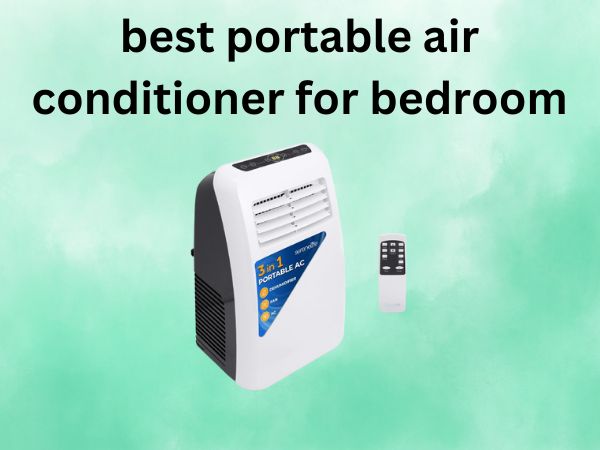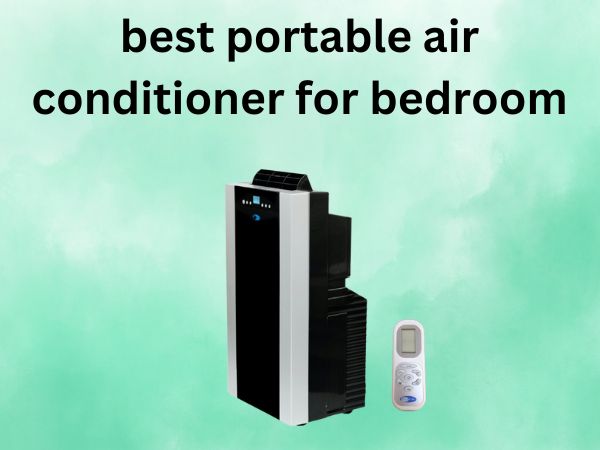5 Best Portable Air Conditioners for Bedroom [In 2026]
Are you tired of tossing and turning in a hot, stuffy bedroom during summer nights? You’re not alone. Finding the perfect portable air conditioner for your bedroom can make the difference between restless nights and peaceful, cool sleep. But with so many options available, how do you choose the right one?
In this comprehensive guide, we’ll explore the top 5 portable air conditioners specifically designed for bedroom use. We’ve analyzed real user experiences, technical specifications, and performance data to bring you honest reviews that will help you make an informed decision. Whether you’re looking for whisper-quiet operation, powerful cooling, or budget-friendly options, we’ve got you covered.
Table of Contents
Top 5 Best Portable Air Conditioners for Bedrooms
1. Dreo AC515S 12,000 BTU – Best Overall
The Dreo AC515S stands out as our top pick for bedroom use, combining powerful 12,000 BTU cooling capacity with remarkably quiet 46 dB operation. This unit excels in rooms up to 400 square feet, making it perfect for larger bedrooms or master suites.
What sets this model apart is its drainage-free cooling system that automatically evaporates condensation when humidity is below 85%. This means no more middle-of-the-night water tank emptying or worrying about overflow. The smart connectivity features, including Alexa and Google Assistant compatibility, allow you to adjust settings without getting out of bed.
The 3-in-1 functionality (cooling, dehumidifying, and fan) provides year-round utility, while the sleep-friendly 46 dB noise level ensures undisturbed rest. Real users consistently praise its ability to maintain consistent temperatures throughout the night without frequent cycling that can disturb sleep.
Pros and Cons
Pros:
- Exceptionally quiet at 46 dB
- Drainage-free operation in most conditions
- Smart home integration with voice control
- Powerful 12,000 BTU cooling capacity
- Large LED display that dims automatically
- Universal window kit fits 17″-53″ openings
- 24-hour programmable timer
- Excellent customer service support
Cons:
- Higher initial cost compared to basic models
- Larger footprint (14.37″D x 17.32″W x 28.13″H)
- Drainage may be required in extremely humid conditions (>85%)
- No heating function
2. Whynter ARC-14S 14,000 BTU – Most Powerful
For those who need serious cooling power, the Whynter ARC-14S delivers with its impressive 14,000 BTU capacity. This dual-hose system efficiently cools rooms up to 500 square feet, making it ideal for large bedrooms or those with challenging conditions like poor insulation or high heat loads.
The dual-hose design is more efficient than single-hose systems because it doesn’t create negative pressure in your room. This means better cooling performance and lower energy costs. The unit features a robust 71-pint dehumidifier capacity, perfect for humid climates where moisture control is as important as temperature control.
While slightly louder at 51 dB, many users find the white noise effect actually helps with sleep. The upward air discharge creates excellent air circulation without direct drafts, and the programmable thermostat maintains precise temperature control throughout the night.
Pros and Cons
Pros:
- Highest cooling capacity (14,000 BTU)
- Dual-hose design for maximum efficiency
- Excellent dehumidification (71 pints/day)
- Covers up to 500 square feet
- Upward air discharge for even cooling
- Award-winning design (Good Housekeeping 2025)
- CFC-free R-32 refrigerant
- Activated carbon air filter
Cons:
- Louder operation at 51 dB
- Frequent cycling in smaller rooms can disturb sleep
- Poor remote control with limited range
- No smart connectivity features
- Larger and heavier than most units
- Narrow temperature differential can cause frequent on/off cycles
3. BLACK+DECKER 8,000 BTU – Best Budget Option
The BLACK+DECKER 8,000 BTU offers excellent value for money without sacrificing essential features. Designed for rooms up to 350 square feet, this unit provides reliable cooling performance at a fraction of the cost of premium models.
Despite its budget-friendly price, this unit doesn’t compromise on important bedroom features. The 3-in-1 functionality includes cooling, dehumidifying, and fan modes, while the 24-hour timer allows you to pre-cool your bedroom before sleep time. The slide-out washable filter and automatic water evaporation reduce maintenance requirements.
The compact design (15.3″ x 14″ x 24.8″) makes it easy to fit in smaller bedrooms, and the dual handles plus casters ensure easy portability between rooms. Many users appreciate the straightforward operation and reliable performance, making it perfect for first-time buyers or those on a tight budget.
Pros and Cons
Pros:
- Most affordable option
- Compact size perfect for smaller bedrooms
- 3-in-1 functionality (cool/dehumidify/fan)
- Easy mobility with handles and casters
- 24-hour programmable timer
- Washable air filter
- Auto water evaporation
- Simple, reliable operation
- Comprehensive window installation kit
Cons:
- Remote lacks backlighting
- Basic features compared to premium models
- No smart connectivity
- Limited to smaller rooms (350 sq ft max)
- Noise level not specified but likely higher than premium units
- No advanced sleep modes
4. SereneLife 8,000 BTU – Best 3-in-1 Function
The SereneLife 8,000 BTU excels as a versatile bedroom companion with its well-designed 3-in-1 functionality. While many units claim multi-mode operation, this model truly delivers effective cooling, dehumidification, and fan functions that you’ll actually use throughout the year.
The unit’s compact footprint (11.6″D x 12.8″W x 27.2″) makes it ideal for smaller bedrooms or apartments where space is at a premium. Despite its smaller size, it effectively cools rooms up to 215 square feet with its 8,000 BTU capacity and 290 m3/hr airflow rate.
What makes this unit special for bedroom use is its thoughtful design elements: rolling wheels for easy positioning, digital touch controls that are intuitive even in low light, and a dehumidifier function that removes 1.2 liters per hour to maintain comfortable humidity levels for better sleep.
Pros and Cons
Pros:
- Compact, space-saving design
- True 3-in-1 functionality that’s actually useful
- Easy portability with rolling wheels
- Digital touch control panel
- Effective dehumidification (1.2 L/hr)
- Flexible window kit for left/right installation
- Good airflow rate (290 m3/hr)
- Budget-friendly pricing
Cons:
- Limited cooling capacity (215 sq ft maximum)
- Vents are not automated
- Moderate noise level at 55-57 dB
- No smart features or app control
- Basic remote control functionality
- Quality control issues reported by some users
5. Dreo 8,000 BTU – Best Ultra-Quiet Option
For the lightest sleepers, the Dreo 8,000 BTU model represents the pinnacle of quiet operation at just 45 dB. This makes it one of the quietest portable air conditioners available, operating at library-level sound that won’t disturb even the most sensitive sleepers.
The patented noise isolation system specifically targets compressor and fan noise, creating an almost whisper-quiet operation. Despite the emphasis on quiet operation, cooling performance doesn’t suffer – the unit effectively cools rooms up to 235 square feet with its 8,000 BTU capacity.
Like its larger sibling, this model features smart connectivity with Alexa and Google Assistant integration, allowing you to adjust settings without getting out of bed. The drainage-free system works in up to 90% humidity conditions, and the sleep curve function through the Dreo app can automatically adjust temperature throughout your sleep cycle.
Pros and Cons
Pros:
- Exceptionally quiet operation (45 dB)
- Smart home integration and app control
- Drainage-free cooling system
- Sleep curve function for optimal night cooling
- Compact size perfect for bedrooms
- Voice control compatibility
- 3-in-1 versatile operation
- Easy installation and mobility
Cons:
- Lower cooling capacity (8,000 BTU)
- Limited to smaller rooms (235 sq ft)
- Premium pricing for the BTU capacity
- May struggle in extremely hot climates
- Requires stable WiFi for smart features
Why Choose a Portable Air Conditioner for Your Bedroom?
Portable air conditioners have become increasingly popular for bedroom cooling, and for good reason. Unlike central air systems that cool your entire home (wasting energy and money), portable units allow you to cool specific rooms when needed. This targeted approach is particularly beneficial for bedrooms where you spend 6-8 hours sleeping.
The flexibility of portable units means you can move them between rooms as needed, making them perfect for renters or homeowners who don’t want to commit to permanent installations. Modern portable air conditioners also come with smart features like app control, voice activation, and programmable timers that sync with your sleep schedule.
For bedroom use specifically, the ability to control temperature precisely throughout the night ensures optimal sleep conditions. Many units feature sleep modes that gradually adjust temperature as your body’s needs change during different sleep phases.
Key Features to Consider When Buying
BTU Rating and Room Size
The British Thermal Unit (BTU) rating is crucial for determining whether an air conditioner can effectively cool your bedroom. As a general rule, you need approximately 20 BTUs per square foot of space. For a typical 200-square-foot bedroom, an 8,000 BTU unit would be adequate, while larger bedrooms (300-400 sq ft) might require 12,000-14,000 BTUs.
However, consider additional factors like ceiling height, insulation quality, window exposure, and heat-generating electronics. A bedroom with poor insulation or western exposure might need a higher BTU rating than the standard calculation suggests.
Noise Levels for Bedroom Use
This is perhaps the most critical factor for bedroom air conditioners. Sleep quality depends heavily on a quiet environment, so look for units operating below 50 decibels (dB). To put this in perspective, 45 dB is comparable to a quiet library, while 55 dB is like moderate rainfall.
Many manufacturers now focus specifically on noise reduction, incorporating advanced compressor designs and sound dampening materials. Some units even feature special “sleep modes” that prioritize quiet operation over maximum cooling power.
Energy Efficiency and Power Consumption
Energy efficiency directly impacts your electricity bills, especially if you plan to run the unit nightly. Look for units with higher SEER (Seasonal Energy Efficiency Ratio) ratings and Energy Star certification when available. Modern portable ACs typically consume between 900-1500 watts, so calculate the potential monthly cost based on your local electricity rates.
Consider features like programmable timers and smart thermostats that can reduce energy consumption by automatically adjusting operation based on your schedule and preferences.
Installation and Portability
While called “portable,” these units still require window venting for the hot air exhaust. Look for units that include comprehensive window installation kits that work with various window types. Some models offer tool-free installation that can be completed in minutes.
True portability comes from smooth-rolling casters and reasonable weight. Units ranging from 45-70 pounds are manageable for most people, especially when equipped with quality wheels and handles.
Comparison Chart of All Models
| Feature | Dreo AC515S | Whynter ARC-14S | BLACK+DECKER | SereneLife | Dreo 8K BTU |
| BTU Rating | 12,000 | 14,000 | 8,000 | 8,000 | 8,000 |
| Room Size | 400 sq ft | 500 sq ft | 350 sq ft | 215 sq ft | 235 sq ft |
| Noise Level | 46 dB | 51 dB | Not specified | 55-57 dB | 45 dB |
| Smart Features | Yes | No | No | No | Yes |
| Drainage-Free | Yes | No | Partial | No | Yes |
| Price Range | High | High | Low | Medium | Medium |
| Best For | Overall performance | Large rooms | Budget buyers | Compact spaces | Ultra-quiet |
Installation Tips for Bedroom Use

Window Installation Best Practices
Proper window installation is crucial for optimal performance and energy efficiency. Start by measuring your window opening to ensure compatibility with the included kit. Most units accommodate windows from 17″ to 53″, but verify this before purchasing.
When installing the exhaust hose, minimize bends and keep the length as short as possible. Each bend and extra foot of hose reduces efficiency. Insulate the exhaust hose with foam sleeve or similar material to prevent heat transfer back into your room – this simple step can improve cooling efficiency by 10-15%.
Seal all gaps around the window kit with weatherstripping or caulk. Even small air leaks can significantly impact performance and increase energy costs. For casement windows, you may need to create a custom panel using plexiglass and proper tools.
Optimal Placement in Your Bedroom
Position your portable air conditioner away from direct sunlight and heat sources like electronics or lamps. The unit should have at least 20 inches of clearance on all sides for proper airflow. Avoid placing it directly next to your bed to minimize noise exposure, but ensure the cool air can circulate effectively throughout the room.
Consider using a small fan to help distribute the cool air more evenly, especially in larger bedrooms. This can allow you to set the thermostat a few degrees higher while maintaining comfort, saving energy and reducing noise from the unit working harder.
Maintenance and Care Tips
Regular maintenance ensures optimal performance and extends your unit’s lifespan. Clean or replace the air filter monthly during heavy use periods. A dirty filter restricts airflow, reduces efficiency, and can cause the unit to work harder and noisier.
Check and clean the exterior vents and intake areas regularly to prevent dust buildup. If your unit has a drain plug, empty it periodically even if it has auto-evaporation features. During off-seasons, store the unit in a dry location and ensure it’s completely dry before storage to prevent mold growth.
Annual professional cleaning of the internal coils and components can significantly improve performance and efficiency. While this involves some cost, it’s much less expensive than premature replacement due to neglected maintenance.
Energy Saving Tips
Maximize efficiency by pre-cooling your bedroom before bedtime rather than running the unit all night. Use the programmable timer to start cooling 30-60 minutes before you enter the room. This approach often provides better comfort while using less energy.
Set the thermostat to the highest comfortable temperature – typically 75-78°F for sleeping. Each degree lower can increase energy consumption by 6-8%. Use ceiling fans or personal fans to create air movement that makes you feel cooler at higher temperatures.
Consider using blackout curtains or reflective window film to reduce heat gain during the day. This reduces the workload on your air conditioner and can significantly impact your energy bills, especially for west-facing bedrooms.
Common Problems and Solutions
Frequent Cycling: If your unit turns on and off frequently, it may be oversized for your room or have airflow restrictions. Check filters and ensure adequate clearance around the unit. Consider using a slightly higher temperature setting to reduce cycling.
Insufficient Cooling: This often results from improper installation, dirty filters, or inadequate BTU capacity for your room size. Verify that the exhaust hose is properly connected and insulated, clean all filters, and ensure no air leaks around the window kit.
Excessive Noise: While some noise is normal, excessive noise may indicate loose parts, dirty filters, or the unit not sitting level. Check that the unit is stable and level, clean or replace filters, and ensure proper installation.
Water Leakage: Most modern units have auto-evaporation features, but excessive humidity or improper installation can cause water issues. Ensure the unit is level, check drain plugs, and verify that the exhaust hose slopes slightly downward toward the window.
Frequently Asked Questions (FAQs)
Q: How much electricity does a portable air conditioner use in a bedroom? A: Most bedroom-sized portable air conditioners (8,000-12,000 BTU) consume between 900-1,400 watts when running. At average electricity rates of $0.13 per kWh, running a unit for 8 hours nightly would cost approximately $30-50 per month. Using programmable timers and optimal temperature settings can reduce these costs significantly.
Q: Can I run a portable air conditioner all night safely? A: Yes, modern portable air conditioners are designed for continuous operation and include safety features like automatic shut-off and overheating protection. However, using programmable timers to pre-cool your room and cycle the unit throughout the night can improve energy efficiency while maintaining comfort.
Q: Do I need to empty water from my portable air conditioner? A: This depends on your model and humidity levels. Many newer units feature auto-evaporation systems that eliminate most water through the exhaust hose. However, in very humid conditions, some units may require occasional manual draining. Models like the Dreo units are specifically designed to be drainage-free in most conditions.
Q: How often should I clean the filter in my bedroom air conditioner? A: Clean or replace washable filters every 2-4 weeks during heavy use periods. In bedrooms where the unit runs nightly, monthly cleaning is typically sufficient. Clean filters ensure optimal airflow, efficiency, and air quality while reducing noise levels.
Q: What’s the quietest portable air conditioner for bedroom use? A: The Dreo 8,000 BTU model operates at just 45 dB, making it one of the quietest available. The Dreo AC515S at 46 dB is also exceptionally quiet for its higher cooling capacity. Both are significantly quieter than most competitors and ideal for light sleepers.
Conclusion
Choosing the right portable air conditioner for your bedroom depends on your specific needs, room size, and budget. The Dreo AC515S 12,000 BTU emerges as our top overall pick, offering the best combination of cooling power, quiet operation, and smart features that make it ideal for bedroom use.
For those needing maximum cooling power, the Whynter ARC-14S delivers exceptional performance for large bedrooms. Budget-conscious buyers will find excellent value in the BLACK+DECKER 8,000 BTU, while the SereneLife model offers great versatility in compact spaces. Finally, the Dreo 8,000 BTU sets the standard for ultra-quiet operation.
Remember that proper installation, regular maintenance, and appropriate sizing are crucial for optimal performance. Consider your room’s specific characteristics, including size, insulation, and heat sources, when making your final decision. With the right portable air conditioner, you can transform your bedroom into a cool, comfortable sanctuary that promotes restful sleep even during the hottest summer nights.





